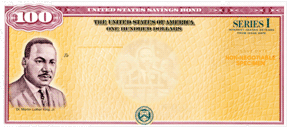MANAGING MONEY - BANKING
Unit Overview
In this unit, the student will learn about the common types of Financial Institutions and the services they offer to help better manage money.
Choosing a Financial Institution
 |
|
Before you choose a financial institution ask yourself the following questions:
1. Is there a minimum amount of money needed to open an account?
2. Will I be charged any monthly fees if I don’t maintain a certain balance?
3. Will there be a penalty if I don’t keep my money in the account for a period of time?
4. Are there fees for services?
5. Is my account federally insured?
6. How much interest will I earn?
7. Is the interest compounded?
Saving Money
Savings accounts are safe places to keep your money. Actually, the bank will even pay you to save your money in their bank. They do this because they use your money to lend to other people. The money you earn in a savings account is called interest. The more money you have in a savings account, the more interest you will earn; the longer the money is in a savings account, the more interest you earn. You want to deposit as much money as possible and keep it there for as long as you can.

Usually you can open a savings account with any amount of money. Take the money you want to save to a bank, complete an application open the account. When you place money in the bank, you are making a deposit. The amount of money you have in the account is called the principal.
Simple interest is money paid on the principal only. To figure simple interest, multiply the dollar amount of the principal by the interest rate by the length of time the money is in the account. For example: let’s say you have $500 (principal) in your savings account for one year and the interest rate is 3%.
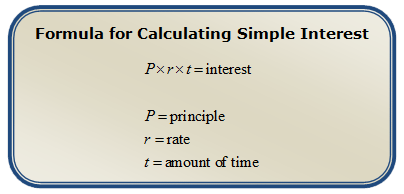 |
$500 x 3% x 1 = $15
You have just earned $15!
Let’s Practice Figuring Simple Interest
Riley opened a savings account with $600 at an interest rate of 4%. How much interest will she earn in one year? Two years? Three Years?
Using the formula for calculating simple interest:
One Year $600 x 4% x 1 = $24
Two Years $600 x 4% x 2 = $48
Three Years $600 x 4% x 2 = $72
Compound Interest
Savings accounts typically earn compound interest. Compound interest is earning additional interest on the interest you have already earned. Once your first interest payment is deposited in your account by the bank, it is added to the principal.
Using the example above, instead of earning 3% on $500, Riley would now be earning 3% on $515. $515 x 3% = $15.45. Her second interest payment will now be $15.45. This new interest payment is added to $515 for a total of $530.45. Now she will earn 3% on $530.45.
In other words, compound interest is calculated each period on the original principal and all interest accumulated during past periods. How much money you earn in interest is also determined by how often the interest is compounded or how often interest is paid. The more often interest is compounded, the more money you will earn.
Study the table below. It shows the result of making a one-time deposit of $1,000 at 5% interest for a period of 10 years. Simple interest earned is $50.00 a year for a 10 year total of $500. If the interest is compounded yearly, the interest earned is $628.89; if compounded quarterly (4 times a year), the interest earned is $643.63.
 |
If you want to figure compound interest there are a couple ways to do so. You can use the formula below or you can use a compound interest calculator provided by Discovery Education: http://www.webmath.com/compinterest.html
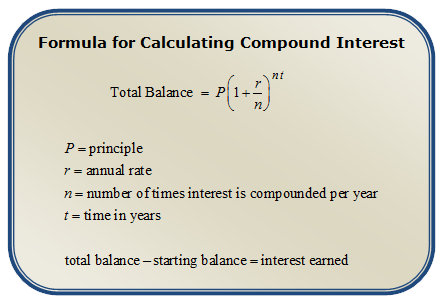 |
Let’s Practice Figuring Compound Interest
Riley opened a savings account with $600 at an interest rate of 4% that will compound monthly. How much interest will she earn in one year? Two years? Three Years?
Using the formula for calculating compound interest:
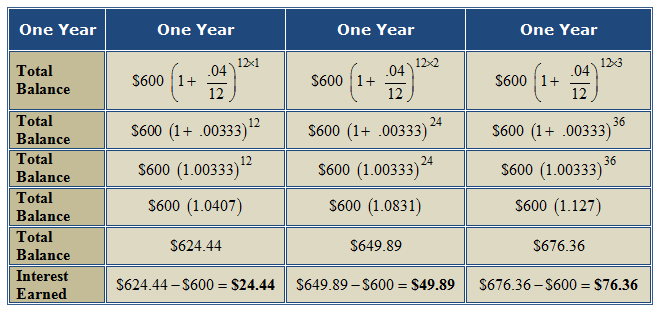 |
Now visit http://www.webmath.com/compinterest.html and calculate Riley’s compound interest after one, two and three years.
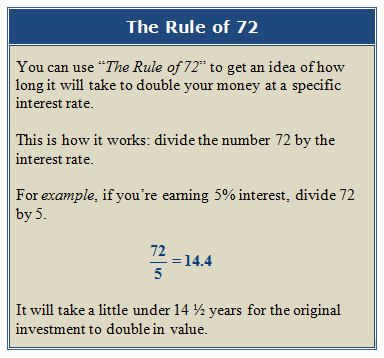 |
Let’s use the Rule of 72 to find out how long it will take Riley to double her money.
It will take Riley 18.5 years to double her money.
Savings Bonds
A second method of savings is to buy savings bonds. You actually buy savings bonds from the Federal Government, although you can purchase them at banks. There are two ways bonds work.
| 1) You can buy a savings bond (series EE) for $25 and in 20 years you can cash in the bond and get $50. In other words, you buy the bond for half of its face value ($25) and cash it in after 20 years for full face value ($50). | 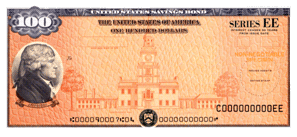 |
| 2) You can also purchase bonds (series I) for their face value – buy a $50 bond for $50 and earn interest. When you cash in this bond it will be worth more than $50. How much depends on the interest rate. Like a savings account, the longer you wait the more money you’ll earn. |
|
 |
FYI: If you have savings bonds and would like to know what they are worth, visit the web site posted below and use the savings bond calculator provided by the U.S. Department of Treasury.
http://www.treasurydirect.gov/BC/SBCPrice
Certificate of Deposit
A third method of savings is to buy Certificates of Deposit (CD). CDs are a bank’s form of savings bonds. You buy a CD for an amount of time like 6 months or 1 year. You agree not to cash in the CD for that period of time. If you do cash in the CD early, you lose money. The CD will earn interest, so it will be worth more money when you cash it in than the amount you bought if for. For example, if you buy a CD for $500 for one year, when you cash in the CD after a year, it could be worth $512.50 or $12.50 more than what you bought it for. Exactly how much more a CD is worth depends on what the interest rate is.
The advantages and disadvantages of each method of saving money are summarized in the table below.
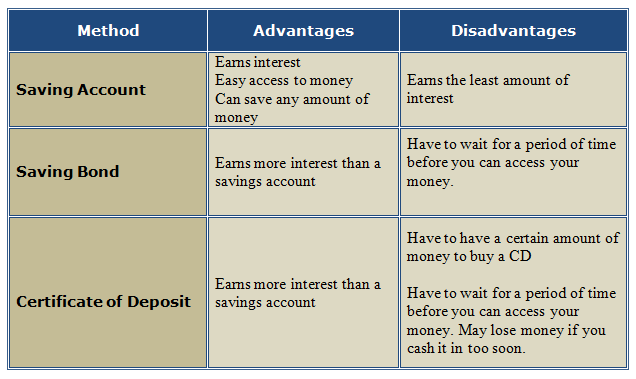 |
Money Market Accounts
Money market accounts are a type of savings account in that you earn interest on your money, but you can also write checks on the account. Usually you are limited in the number of checks you can write each month. You earn more interest with a money market account than a regular savings account; however they also require larger initial deposits.
No matter what type of account you choose, saving money is a good thing. Shop around for an account that offers you compound rather than simple interest.
Banking Basics
Read pp 1-21 of the Federal Reserve Education PDF document Banking Basics.
